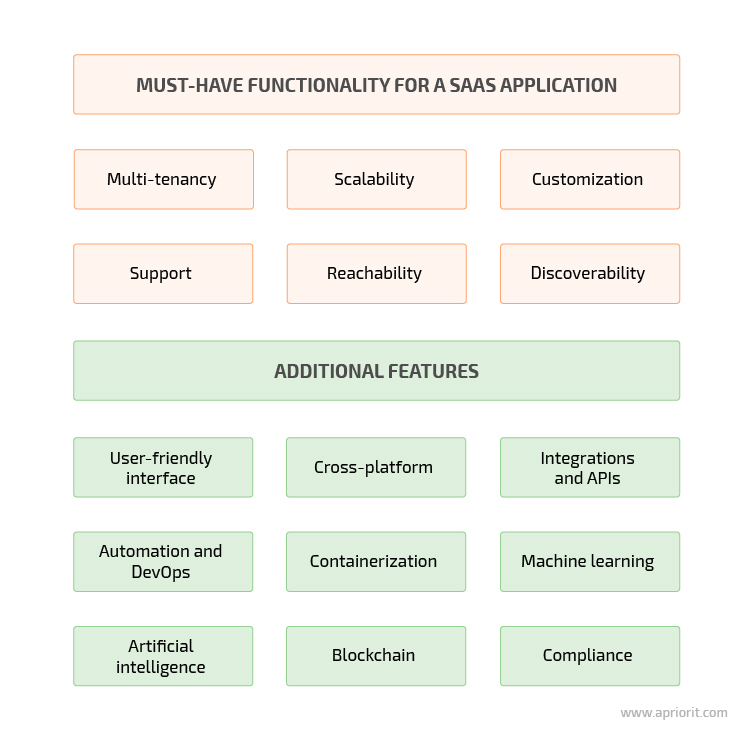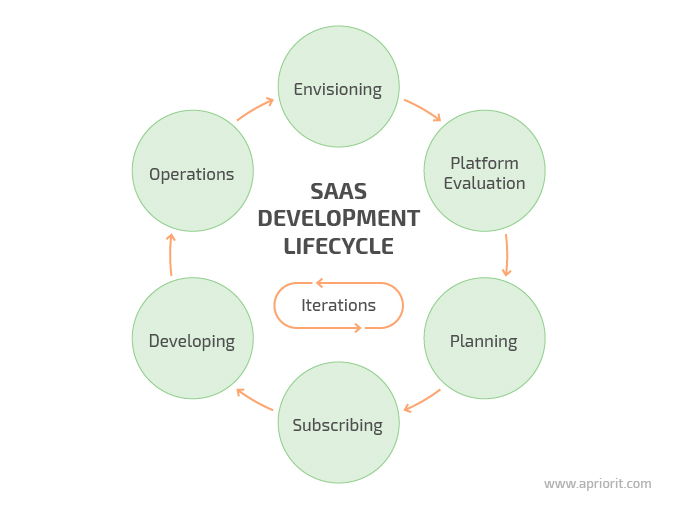With cloud services becoming increasingly popular, more and more companies are looking into developing their own SaaS projects. The SaaS market grows steadily each year. Gartner predicts that by 2022, total revenue for this market will reach $143.7 billion. Now might be the perfect time to start your own SaaS project.
However, not all SaaS project developers realize the unique set of challenges that come with developing a cloud solution. In this article, we discuss essential design elements and technologies for a successful SaaS application and the key stages of the SaaS development lifecycle (SaaSDLC).
This article will be useful for developers and project managers looking into new SaaS projects.
Contents:
Vertical and horizontal SaaS applications
There are two major types of SaaS solutions: horizontal or vertical. Let’s take a look at both approaches.
A horizontal application focuses on the needs of a particular department or function, not taking into account industry specifics. Well-known horizontal apps include Workday, Salesforce, Dropbox, and HubSpot.
Horizontal SaaS solutions used to be popular because they’re the “all things to all people” type of solution. They cover the basic needs of a certain department. In order to stay on the market, such an application has to be user-friendly, highly customizable, and easy to integrate with other SaaS products. For example, if you’re working on a cloud-based accounting service, make sure you have APIs to integrate data from your application into popular HR solutions, as accounting and HR systems usually work together.
The biggest flaw of a horizontal SaaS is the need to deploy several solutions in an organization. Maintaining all the solutions becomes more and more difficult for the IT department as a company grows.
A vertical application focuses on the needs of a specific industry. It may combine functionalities for several departments in one platform, but each functionality is tailored for a certain industry. Examples of vertical applications are Veeva (for pharmaceutical management), Guidewire (for property insurance), and Infor (for manufacturing). Another kind of vertical app provides one key function for a business. For example, SharpSpring provides marketing automation.
Vertical SaaS development is currently trending. More companies are turning to such applications because they solve very specific business challenges while providing supporting functionalities for non-priority departments. For example, we used vertical structure during SaaS project management solution development.
Developing a vertical application is more challenging because it requires expert knowledge of industry-related issues. Customization and integration capabilities earn some bonus points, but they aren’t as important for a vertical SaaS solution as they are for a horizontal.
Challenges of SaaS development
The SaaS market is highly competitive and cluttered. G2, a business software and services review platform, lists more than 34,000 vertical SaaS companies in 745 industries. It’s almost impossible to count all the horizontal SaaS applications.
Creating a solution that will find its place on the market and in the hearts of users is tricky. The challenges start with selecting a cloud provider. Your choice of provider is one of the most important factors in your app’s performance. It’s also quite hard to change the provider once a SaaS product is deployed.
Another potential challenge is the number of helpdesk calls and support tickets you may get. Support can bring operation costs way up, so the goal is usually to minimize these calls and tickets and automate as much as possible. This, however, requires timely updates and patches, which the SaaS developer should be ready to provide.
A SaaS solution is part of a client’s IT infrastructure. That’s why integration with the most popular enterprise resource planning (ERP), HR, accounting, ticketing, and other systems must be a priority. Ideally, your application should be equipped with a lot of APIs.
While developing your software, keep in mind compliance with regulations. There are two types of IT regulations you need to be aware of: those related to general data protection (e.g. GDPR, NIST) and industry standards (e.g. SWIFT, HIPAA, PCI DSS).
In order to prepare for all these challenges, you need to understand what kind of SaaS application you want to build and how to build and implement it. Let’s start by discussing key features of any SaaS application.
Read also:
How to Develop a SaaS ERP Platform
Essential design elements of a SaaS platform
The cloud industry has very high standards for services. Multi-tenancy, scalability, customization, support, reachability, and discoverability are a must for a SaaS application. Apart from that, there are a lot of other aspects you should consider while designing an application:
- Usability and a user-friendly interface — Your SaaS interface must be intuitive and easy to use. Customers won’t want to spend extra time studying your application and teaching employees to work with it.
- Cross-platform — The ability to access data from any location and device is the strongest advantage of a cloud-based solution. That’s why dedicated website versions or applications for Android and iOS devices are necessary for any SaaS product.
- Integrations and APIs — APIs provide easy access to parts of a client’s IT system, allowing engineers to create an ecosystem on the customer’s premises. When working out the integration capabilities of your SaaS, focus on customer expectations and industry-specific demands.
- Automation and DevOps — Customers expect their SaaS application to be bug-free and to adopt new market trends. In order to live up to their expectations, you have to achieve development velocity. The best way to do this is to automate your development with DevOps tools.
- Containerization — A SaaS solution has to perform the same way with any cloud or environment and provide seamless integration into any system. Currently, the best way to achieve that is to develop your solution with a containerization platform like Kubernetes or Docker.
- Machine learning (ML) and artificial intelligence (AI) — Both of these trendy technologies are used to automate SaaS applications and help a client get useful insights by analyzing their data. The depth of implementation of these technologies fully depends on your team’s knowledge, as ML and AI provide you with tools to create anything from automated email responses to revenue predictions.
- Blockchain — Security is still a major concern for any customer choosing a cloud service. Ensuring SaaS data protection with blockchain makes stealing it nearly impossible. Also, implementing this technology wins extra points for marketing.
- Compliance — Complying only with IT standards is no longer enough for SaaS solutions. Keeping in mind the trend of vertical applications, you also need to comply with industry regulations. With some sectors like healthcare, banking, and government, this can be tricky, so you need to research applicable regulations before the start of development.

By combining all of the above-mentioned elements, you’ll be able to create a SaaS platform that meets all of your customer’s requirements.
Software development methodology
The term “software development lifecycle,” or SDLC, usually describes a particular methodology used for developing and implementing software. Examples of such methodologies include:
- Waterfall – Development moves through several sequential phases with an emphasis on planning and scheduling
- Spiral – The project is divided into cycles, with a development model for each cycle chosen based on the immediate risks
- Iterative – The project is developed on a smaller scale and then grows through several iterations
- Rapid application development – Emphasis on prototyping versus planning in order to speed up the development process
- Agile – Iterative development with an emphasis on communication and refinement via feedback
- Scrum – An additional layer to Agile that implements a living backlog, regular planning, and sprint retrospectives
There are many other development methods out there. And while Agile and Scrum may be the most popular right now, each has its own set of strengths that makes it useful for specific situations. However, the methodology you use can change depending on what best reflects the particular requirements of your project.
SaaS development lifecycle
The development lifecycle for a SaaS product differs from the traditional software development lifecycle. There are several factors affecting the choice of core architecture for a SaaS platform, the most important of which is the cloud provider. The need to provide scalable service with multi-tenancy presents an additional challenge.
In order to prepare for all these challenges, you need to understand the general SaaS implementation methodology and the specifics behind it. The best and fastest way to get a general idea of how SaaS development works is to examine the SaaS development lifecycle.
Note that the SaaSDLC is a cycle, as work on the application goes on after its release. After an application is launched, you have to iterate through phases 3–6, from planning to operations.

Envisioning
The envisioning phase for a SaaS project is similar to the envisioning phase for any other type of software project. In this phase, the vision and scope of the project are defined from the business standpoint. It’s important to involve all stakeholders in a discussion about the project: investors, architects, developers, marketers, product managers, salespeople, cloud consultants.
This phase includes:
- Creation and validation of the app idea
- Market research
- Identification of business needs and opportunities
- Creation of short-, medium-, and long-term business plans
- Negotiations with potential partners and investors
- Assessment of various cloud architectures
Evaluating
Though platform evaluation is part of the typical software development lifecycle, this phase is particularly important for a SaaS project. The capabilities and architecture of the chosen cloud service have a large impact on the final solution architecture. Also, it’s extremely challenging to migrate to a different cloud provider or change the architecture of a project when it’s operational.
When searching for a platform, it’s important to:
- Formulate requirements clearly
- Define the technical architecture and functionality of your future SaaS solution
- Pay attention to platform performance, scalability, containerization capabilities, reliability, and disaster recovery
- Evaluate security and data privacy
- Create a financial plan and evaluate monetization models for your SaaS
- Learn about management tools and levels of support
- Plan the design and implementation processes, taking into account the limitations of the chosen platforms
Planning
The planning stage is the time to make all decisions that affect the success of a SaaS application on the market. Activities and deliverables from this phase depend on the complexity and size of your service. Usually, planning includes:
- Formalizing requirements from stakeholders into technical specifications for developers
- Finalizing decisions regarding staff, project plans, and functional specifications
- Creating a project schedule, road map, and script plan
- Creating communication and marketing activity plans
- Working out a risk mitigation strategy
The planning phase should be repeated for each iteration and should be the first phase of every iteration. When planning, you need to focus both on the long-term vision of the project and on more detailed requirements for the current iteration.
Read also
Best Practices for Secure SaaS Development (+ Tips from a Cybersecurity Expert)
Learn how adopting a secure-by-design mindset helps SaaS companies prevent vulnerabilities early, reduce remediation costs, and build resilient cloud products.

Subscribing
This is the phase when you set up your subscription with the selected cloud provider. At this point, you should:
- Finalize major decisions regarding the architecture and pricing
- Test services and study the documentation of selected cloud providers
- Validate the data privacy and regulatory compliance of your provider
- Formulate backup and disaster recovery plans and a subscription management strategy
- Sign a service-level agreement with the chosen provider
During each iteration, your subscription can be revised in order to make sure that your selected cloud provider and chosen level of service best reflect all the requirements of the project. This doesn’t mean you should take choosing and subscribing to a platform lightly, however. Migrating to a new platform can be long and challenging.
Developing
During the first iteration, you create the core feature set based on the selected architecture. Then you can add new functionalities, updates, and improvements to that core. The scope of each following iteration is decided during the planning phase depending on the specifics of the project.
The development phase includes:
- Setting up a development environment
- Developing, deploying, and conducting various forms of testing
- Adding security functionality and policies
- Streamlining data synchronization, extraction, and uploading
- Integrating and testing support and helpdesk processes
In SaaS projects, testing plays a critical part, considering that extra support calls and tickets post-launch can ramp up operational costs of the service. Therefore, it’s important to conduct testing at every stage of software development. Rigorous load and performance testing should also be performed, since SaaS platforms usually operate under heavy workloads.
Operations
During the operations phase, you have to deploy and maintain your application. To launch successfully, take into account the insights you gained during the previous phases. At this point, you have to:
- Finalize your support plan and personnel training plan
- Conduct disaster recovery, backup, and load testing
- Plan the deployment
- Integrate your application into a cloud platform
- Monitor and tune the performance
- Gather initial feedback in order to plan further iterations
After the system is deployed, the lifecycle of SaaS service development continues. It’s important to provide frequent updates and security patches in order to minimize the number of support calls and constantly improve the user experience.
Conclusion
Each SaaS project is unique, and it’s impossible to prepare yourself for all possible interruptions. However, considering the key requirements for SaaS solutions, the demands of your targeted industry, and feedback from clients will help you avoid a lot of potential pitfalls.
The lifecycle of SaaS development is a continuous process of creation, maintenance, and support. That’s why the SaaS development lifecycle has become a gold standard for development companies around the world. However, it’s possible to make it even more effective by adding your experience and industry context.
Not sure where to start? Contact our SaaS software development team to discuss your project!




